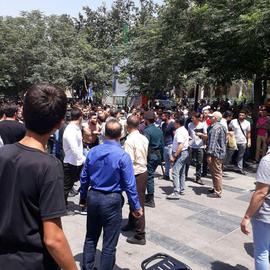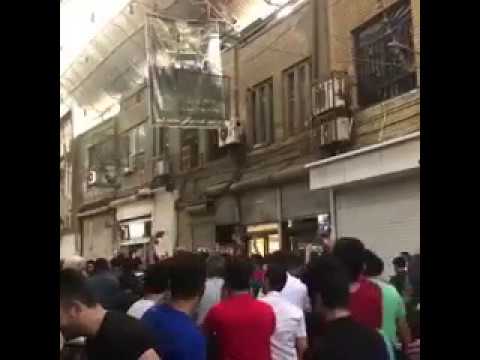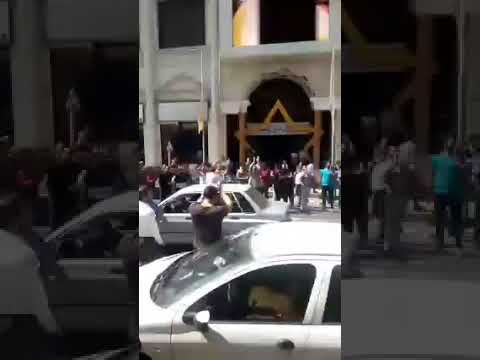Protests have broken out across Tehran in response to rising prices and the sharp fall in the value of Iranian currency. The unrest started on Monday morning in Tehran’s Grand Bazaar and soon spread to southern and central parts of Tehran. And there were reports that bazaar traders in the cities of Shahriar in Tehran province, Ahvaz in Khuzestan and Qeshm Island in the Strait of Hormuz have also gone on strike and staged protests.
In Tehran, riot police fired tear gas to disperse the crowds as people headed toward the Iranian parliament. Witnesses posted videos on social media showing the harsh police action against the demonstrators, as well as protesters setting police motorcycles on fire.
Traditional Tehran bazaars have always been considered a bastion of support for the Islamic Republic and its authorities. In the events leading to the 1979 Islamic Revolution, the bazaaris were one of the key forces that helped bring the downfall of the monarchy. But now, after 40 years, these bazaars are now the site of protests that have quickly turned into anti-government demonstrations — similar to the events of late December 2017 and early January 2018, when a wave of nationwide protests started in the holy city of Mashhad and spread across the country.
Above: Strike and Protests at Tehran Bazaar on Monday June 25
Fire Under the Ashes
But, just as in December and January, many conservative principlists have appeared pleased by the protests, which they view as public opposition to President Rouhani’s government.
“The government must recognize that there is fire under the ashes as a result of economic instability and the current economic situation,” said Ahmad Karimi Esfahani, a member of the conservative Islamic Coalition Party. “This was caused by the negligence and lack of wisdom on the part of the government, the head of the government and his economic team. They were also insincere and did not talk to people truthfully. This is what set the stage for [the protests].”
Yahya Rahim Safavi, former chief commander of the Revolutionary Guards and currently Ayatollah Khamenei’s military advisor, expressed similar — if less direct — sentiments, implicitly stating that Rouhani’s government did not have the competence to run the country.
But as with the previous protests, some Rouhani supporters believe the protests are the brainchild of the president’s opponents. “The voice of the street, of the mall and the bazaar must be heard,” wrote Hessamoddin Ashna, Rouhani’s advisor, on his Telegram channel. “The first is the voice of the people but the second and the third voices must be judged more cautiously so that we do not mistake the voice of the impoverished with those of the wheelers-dealers.”
Abdollah Esfandiari, President of Tehran Bazaar’s Board of Trustees, told Fars News Agency that the reasons behind the protests were the high price of hard currency and its unpredictable fluctuations, market stagnation, low demand and high prices.
Above: Furniture sellers in Tehran Bazaar join the protests
Familiar Chants
Today’s chants were also similar to those heard in the December and January protests: “Reza Shah, rest in peace,” “Death to the dictator,” “No Gaza, No Lebanon; I will give my life for Iran” and “Let go of Syria — Show some care for us.”
Smaller demonstrations also took place in Aladdin and Charsou shopping malls on Sunday, June 24, when the price of the US dollar hit a record, valued at 9,000 tomans to the dollar.
In Iran, the dollar has two prices. The first is the one the government sets for what it considers to be “necessary” imports and payments outside Iran. The second, much more expensive, price is a fluctuating one in the free market. According to Iranian Students News Agency, after the recent protests, Valiollah Seif, the governor of Iran’s Central Bank, and other government officials have been talking about introducing a “third price,” somewhere between 6,000 to 6,5000 tomans, for “unnecessary” imports. And yesterday, First Vice President Eshagh Jahangiri told a closed-door session of parliament that, to control the economic crisis, the government might ration petrol and other goods.
As of now, President Rouhani’s administration has not offered a clear strategy to deal with the fast-spreading protests and strikes that started at the end of 2017. A number of factors have confounded its efforts to control the economic crisis, including President Trump’s exist from the nuclear agreement, uncertainty over the outcome of negotiations with Europe to save the nuclear agreement, anxiety over the return of oil sanctions, the flight of capital and failed policies that were meant to control the currency market.
Prior to the most recent protests, President Rouhani had referred to the winter protests as “psychological warfare.” But it does not matter how officials classify it. What has been happening can be interpreted as a scheme hatched by Rouhani’s opponents, the consequences of the Trump decision or an uprising by people who are tired of high prices and economic instability. Regardless, today’s protests show that this is a real war.
More on recent nationwide protests in Iran:
Ayatollah Khamenei Blamed for Recent Protests, May, 2018
Interior Minister Warns of Future Protests — But Offers no Solutions, March 13, 2018
More Protests to Come as Widespread “Discontent and Mistrust” Continues, February 28, 2018
Does Khamenei’s Apology for “Injustice” Mean Anything?, February 19, 2018
Protests in Iran: A Chronology, January 5, 2018
European Citizen Among More than 1000 Arrested in Iran Protests, January 4, 2018
Why Reformists Do Not Empathize with the Protesters, January 2, 2018
Hundreds Arrested in Iran as Protests Continue, January 2, 2018
People Have Left the Reformists Behind, January 2, 2018
A second revolution in Iran? Not yet., December 31, 2017
Eyewitness Reports of Protests at Tehran University, December 31, 2017
Iran Officials Blame Each Other and Foreigners for Protests, December 30, 2017
Isfahan’s Friday Prayers Leader: Praising the Shah Was Shocking, December 30, 2017
Protests in Iran Do Not Spare the Supreme Leader, December 30, 2017
Iran Rocked by Second Day of Street Protests, December 29, 2017
visit the accountability section
In this section of Iran Wire, you can contact the officials and launch your campaign for various problems



























comments